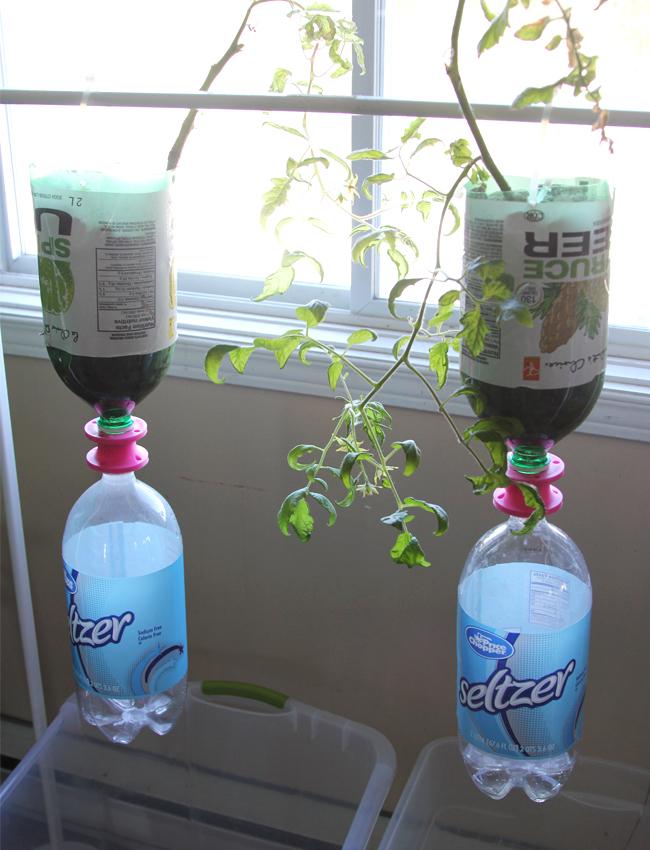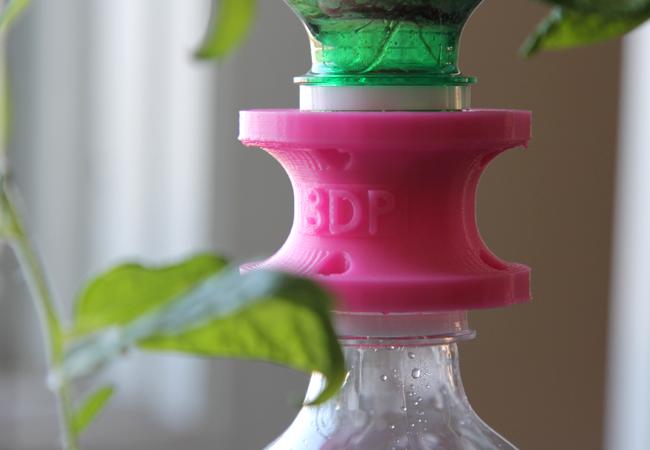 The 3DPonics simple version for making a gardening system falls into our ‘must-have, gotta try this’ category. Not only does 3D printing lend innovation and affordability to this technique of gardening, it offers tremendous ease. Virtually no parts are needed, and if you are a soda or seltzer water enthusiast, you’ll find a great way to recycle those 2-liter bottles to attach to your 3D printed gizmo.
The 3DPonics simple version for making a gardening system falls into our ‘must-have, gotta try this’ category. Not only does 3D printing lend innovation and affordability to this technique of gardening, it offers tremendous ease. Virtually no parts are needed, and if you are a soda or seltzer water enthusiast, you’ll find a great way to recycle those 2-liter bottles to attach to your 3D printed gizmo.
While it may look like a simple apparatus meant to hold an ornamental plant, or grow herbs to accentuate your spaghetti, 3DPonics and the science behind it have wide-ranging implications, literally, as in perhaps all the way into space—if the creators complete their mission as planned.
In coordination with the Rhode Island STEM Center (at Rhode Island College), 3DPonics has been working to help integrate and generate interest in the student body not just in the fascinating technology of 3D printing, but using it in the future also for–drum roll, please—space gardening. And while that might sound a bit farfetched to some, for most who are involved in the technology it’s not so much a stretch. There are numerous entities, including NASA, interested in taking 3D printing to space.
Sustainability is the issue in space, and the main requirement in figuring out realistic logistics for colonization as well as life at a space station. Being able to grow food is already something well-considered, but 3D printing offers additional and previously unheard of sustainability.
 While sending their products into space is a lofty but not entirely out-of-the-question goal, the most immediate plan between 3DPonics and the Rhode Island STEM Center is to get this technology in front of students, as it encompasses all the disciplines of science, technology, engineering and manufacturing.
While sending their products into space is a lofty but not entirely out-of-the-question goal, the most immediate plan between 3DPonics and the Rhode Island STEM Center is to get this technology in front of students, as it encompasses all the disciplines of science, technology, engineering and manufacturing.
“This is a big step forward, as one of our main goals is to get the system—a practical 3D printing-hydroponics project—inside classrooms,” said Michael Golubev, CEO of 3Dponics. “We’ll be providing the Rhode Island STEM Center with the ready-to-print digital files, the proprietary operating systems and of course any tech support they need to develop their seminar.”
While a more complex collection of 3D files is shared for students to make 3D printed hydroponics, 3Dponics is currently spreading the word about their simple system which really only requires one 3D printed part, via the 3D printed bottle connector, printed at medium quality with the following specs:
- 0.2 mm
- 10% fill
- 2 shells
The 3D printed connector is responsible for creating the system with one bottle upright and the other facing down. The only other required items are the three plastic bottles, a grow medium, and a nutrient solution. Each bottle screws into the connector. The plant is added and surrounded with grow medium, all very gently of course. The ‘system’ is then placed on a level surface, or can even be hung on the wall.
 If you were wondering ‘hmmm…why the third bottle?’ Well, this is your nutrient mixing bottle, which will then act as the vehicle for pouring the solution into the planter, thus watering the plant. Even cooler, once all that water has drained into the bottom plastic bottle, just unscrew it and replace it with the empty bottle, until the next time you water—and then yes, ‘rinse and repeat.’
If you were wondering ‘hmmm…why the third bottle?’ Well, this is your nutrient mixing bottle, which will then act as the vehicle for pouring the solution into the planter, thus watering the plant. Even cooler, once all that water has drained into the bottom plastic bottle, just unscrew it and replace it with the empty bottle, until the next time you water—and then yes, ‘rinse and repeat.’
The complete collection of 3D files should also be a digital delight for students to uncover and begin to use, featuring all the parts necessary to set up a complete 3D printed hydroponics system. Files are included for:
- A floater, crucial to controlling water levels
- A floater nozzle, which allows you to use an empty plastic bottle as the floater instead
- The receiver, holding the floater in place
- The nut, which screws onto the receiver
- The airlock, preventing air/water from escaping the tube
- A planter, in either square or round option
- A bottle stand, for positioning the bottle correctly
While this partnership is a way to further STEM education and give college students great skills to take with them into the world post-graduation, 3DPonics also wants to make a simple but very fun demonstration of exactly how technology and ‘space gardening’ can transform socioeconomics. While this 3D hydroponics system is probably just the thing to sustain space travelers, it’s pretty perfect here on earth too.
Would you like to 3D print the connector for this system and put one together easily at home? Share with us in the 3DPonics Space-Gardening System forum over at 3DPB.com.
Subscribe to Our Email Newsletter
Stay up-to-date on all the latest news from the 3D printing industry and receive information and offers from third party vendors.
You May Also Like
3D Printing Financials: Prodways’ Q1 2024 Revenue Drop and Accounting Overhaul
Prodways (EPA: PWG) has released its earnings report for the first quarter of 2024, announcing modest revenue. This result is lower than last year’s, reflecting the company’s ongoing adjustments to...
3D Printing Financials: Prodways Faces Headwinds, Cuts Jewelry Printers and Cristal Dental Lab for Turnaround
Prodways (EPA: PWG), a European leader in industrial 3D printing, encountered financial challenges in 2023, as revealed in its earnings report. The company saw a decline in revenue and profitability...
Printing Money Episode 12: Q3 2023 Earnings Reports with Troy Jensen, Cantor Fitzgerald
Episode 12 of Printing Money brings with it a slightly different approach, as Alex Kingsbury sits this one out while Danny runs the show. Equity research analyst Troy Jensen, now of Cantor...
3D Printing News Briefs, November 18, 2023: Depowdering, Jewelry Patterns, & More
We’re kicking off 3D Printing News Briefs with a little business today, as Horizon Microtechnologies invested in a micro AM platform from Boston Micro Fabrication, and Rivelin Robotics announced a...






























